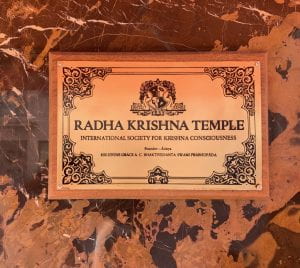ISKCON, the International Society for Krishna Consciousness, is a devotional form of worship to the Hindu deity, Krishna. Krishna is the major deity of the movement and they chant his name. Hare Krishna is the highest form of prayer that contains everything you want Krishna to know and it signifies devotionalism because “Krishna tells us in the Gita (9:26) that he will accept whatever is offered with devotion (Hopkins 191).”
In Thomas Hopkin’s ISKCON’s Search for Self-Identity, he explains how ISKCON began with Bhaktivedanta Swami Prabhupad’s first temple at 26 Second Avenue in New York City. The movement’s first Guru, more commonly known as Prabhupad, came to America when he was 70 years old. Until his death at 81, Prabhupad translated texts from Sanskrit, wrote letters and commentaries on devotional texts, and publishing a journal called Back to Godhead. Prabhupad’s goal was to leave as much information as he could about devotion and Hindu culture as he could to his English-speaking disciples. After his death in 1977, there was a gap from 81-year-old Prabhupad to his disciples, the oldest was still under 40 (Hopkins 177). While they were declared sannyasis and became, more or less, independent gurus, they were immature in their devotional life.
Traditionally, knowledge, especially of gurus, was passed from one guru to his personal disciple. This ensures an unbroken flow of knowledge. Also, the guru would be able to ensure that his disciple is passed down the same knowledge he received, thus keeping the information consistent throughout time. When Prabhupad passed, he left behind the GBC, the Governing Board Commission, consisting of a dozen disciples. Almost immediately, they had issues that couldn’t be reconciled “because there was no older generation of mature devotees in ISKCON (Hopkins 182).” Thus, various members of the GBC began to splinter and largely focus on devotion to Prabhupad’s teachings, not necessarily focus on devotion to Krishna.
In the presentation at the ISKCON temple, Kavi Karnapura explained the lineage of gurus. Information from gurus would be passed down from one to another. Recently, given the rise of the GBC, multiple members can claim they are the next guru. This has led to a splitting off from the former lineage. Since this is the case, the next guru is being discussed and debated. Ultimately, different temples could decide to follow different gurus, leading to a possible splintering of the ISKCON movement.
My experience of the ISKCON service was surprising. There was virtually no sermon. While flames, water, and flowers were passed around, the devotees were free to worship however they felt. They chanted together, danced, and made different gestures to honor the deity. The service seemed very personal to how each individual wanted to worship, but they were all able to come together with chants and mantras. While devotees who are initiated would care about the lineage of the gurus and the information passed down, I think it would be interesting to see how the change in gurus would change the service in the temple.


